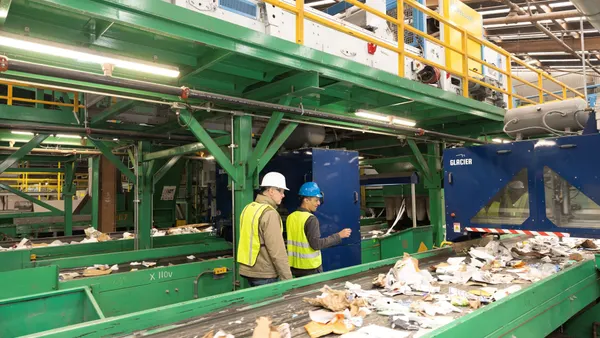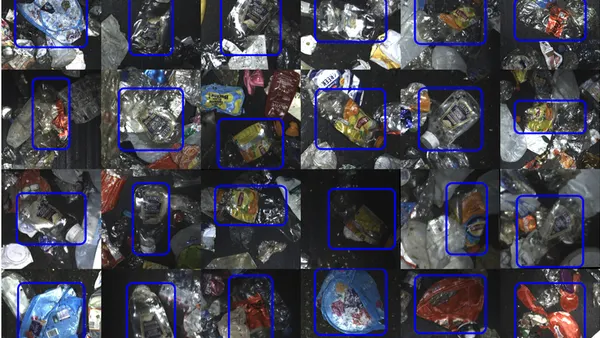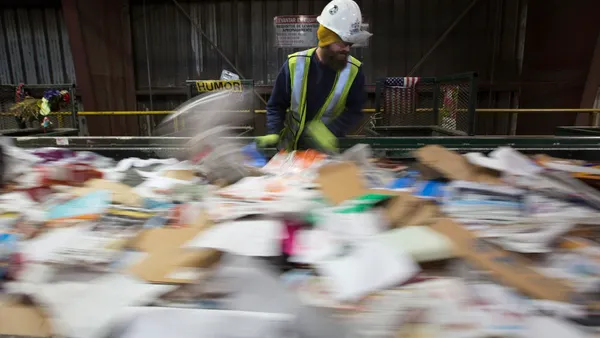Best Buy wants to keep electronics out of disposal sites — for a price.
In order to cut back on e-waste, the retailer in April launched a home pick-up recycling service.
Now, customers anywhere in the U.S. can request pickup for their old electronics. The service will remove and recycle up to two large products — like TVs and major appliances — and smaller items like laptops, cameras, and gaming consoles. With 70% of people living within 10 miles of a Best Buy store, the service is convenient for a large portion of the population.
The Standalone Haul-Away service is $199.99, with those subscribed to its membership program, Best Buy Totaltech, saving 20%.
“We feel we have an important role to play in helping our planet, including being there for the entire lifecycle of a product — from the time a customer starts shopping until that product is responsibly recycled,” Tim Dunn, Best Buy’s head of environmental sustainability, said in a statement. “This new service will make this important work even more convenient for customers.”
Best Buy says that it is the nation’s largest retail collector of e-waste, with the company collecting over 2 billion pounds of electronics and appliances since 2009. In 2021 alone, the company said that it collected over 192 million pounds of consumer products for recycling. But, are customers willing and able to spend nearly $200 to properly dispose of their e-waste? And do they need to?
The problem with electronic waste
E-waste refers to discarded products with a battery or electrical plug. And it’s a big problem.
E-waste is forecast to double by 2050, and is the fastest growing solid waste stream, according to a collaborative report between The Solving the E-waste Problem Initiative, The Sustainable Cycles Programme, and The International Environmental Technology Centre, which is a branch of the United Nations Environment Programme. Around 50 million metric tons of e-waste is generated globally each year, with the report describing it as the equivalent to the weight of 5,000 Eiffel Towers.
As a retailer, Best Buy says that its home pick-up recycling service is part of the company’s continued commitment to protect the environment, and that sustainability has been at the core of its mission for decades.
Best Buy’s new service joins a few recycling options the retailer already has in motion. The company has a Haul-Away offering for shoppers when they purchase a new television, major appliance or fitness equipment wherein old products can be taken away for a small charge. Customers can also drop off up to three electronics per household, per day at Best Buy stores through its everyday recycling program. Shoppers can also participate in the company’s trade-in program, which offers gift cards in exchange for electronic items of value.
“We help keep devices in use longer and out of landfills by leveraging our customer trade-in program, Geek Squad repair services, responsible recycling and Best Buy outlets,” Best Buy CEO Corie Barry said on a recent call with analysts. “These are initiatives our customers and vendors value and capabilities no one else has at our scale and breadth.”
“If you use a free program because your state mandates that the manufacturers are responsible, it still requires you to lug [products] around, or put it in a box. And you have to get the box."

Stacy Savage
Founder & CEO, Zero Waste Strategies
But while Best Buy touts its latest recycling efforts, the latest of which costs the consumer a couple hundred dollars, many states have free e-waste recycling programs. Twenty-five states have passed legislation mandating statewide e-waste recycling. Currently, 65% of the U.S. population is covered by a state e-waste recycling law, according to the Electronics TakeBack Coalition. In most states, the manufacturers must pay for it.
Even though many people reside in states that have e-waste legislation, many may not know that it is an option, according to Stacy Savage, founder and CEO of Zero Waste Strategies. “If the equipment manufacturers have not taken on the responsibility of saying, ‘Hey, there’s a law in your state where we’ll take back your stuff for free and recycle it,' then there’s that education gap.”
Best Buy, then, is stepping in as a middle man to take care of some of these responsibilities. Savage thinks of Best Buy’s new home pick-up service, with its price tag, as a “good exchange, because of the convenience factor.”
“If you use a free program because your state mandates that the manufacturers are responsible, it still requires you to lug [products] around, or put it in a box. And you have to get the box,” she said. “You can print out the mailing label at home. But what if you don’t have a printer?” The number of logistics ultimately adds up, she said, which can lead many people to pay for the convenience. “I think [Best Buy] is stepping up to fill a service gap.”
The service is likely to appeal to customers that have a few large items, and even though $200 is expensive, it is a “reasonable alternative” to similar services, according to Carlos Castelán, managing director of The Navio Group.
"Best Buy’s recycling service makes a lot of sense for the retailer given the popularity of its current electronics recycling programs where customers can drop off old electronics at a local store,” Castelán said via email. “Add in the fact that consumers are increasingly looking to companies for solutions around sustainability and the service is a great extension of the retailer’s current program.”
Tech advancements versus sustainability
A number of actions can be taken to pull back on e-waste, including creating electronics products that last longer and are more easily repairable.
President Joe Biden backed the last point in July 2021, through an executive order that addressed consumers’ right to repair their devices. Biden encouraged the Federal Trade Commission to establish rules that bar unfair methods of competition, including cell phone manufacturers and others blocking independent repair shops.
“Tech and other companies impose restrictions on self and third-party repairs, making repairs more costly and time-consuming, such as by restricting the distribution of parts, diagnostics, and repair tools,” the White House stated.
Companies seem to be getting the message. In late April, Apple announced that self-service repair was available in the U.S. and would soon expand to other countries. The program provides repair manuals and Apple parts and tools through its Self Service Repair store. Customers are able to perform repairs on the iPhone 12, 13 and SE (3rd generation), with the ability to work on repairs on Mac computers with Apple silicon coming later in the year.
But, technological advancements are a major contributor to e-waste. “I wish consumers understood that companies bank on planned obsolescence. It is part of their entire business model,” Savage said.
A recent report by Global Industry Analysts regarding electronics recycling states that the future of e-recycling is highly influenced by tech advancements, the increased affordability of electronic devices and consumers’ proclivity to purchase items, thereby shortening the replacement cycle. “The insatiable desire for electronic devices and mushrooming streams of next-generation items, from smartphones and smart TVs to refrigerators and displays, has resulted in burgeoning volumes of e-waste,” the study states.
In Best Buy’s shareholder presentation for Q4, it shared that domestic category growth drivers for the company included appliances, headphones, home theater and virtual reality products — items that are ripe for technological advancements.
On a call with analysts about the quarter, Chief Merchant Jason Bonfig used televisions and laptops as examples of products that receive improvements. "These continued evolutionary innovation cycles are never ending, and they drive growth," Bonfig said. "They create reasons to upgrade and unlock new and better experiences for our customers each and every year.
Best Buy said that people will continue to use technology more, and will thus need or want to replace or upgrade products. Between 30% to 50% of people who purchased tech items specifically for pandemic-related reasons “plan to upgrade or replace those purchases,” the company said in its presentation.
However, Bonfig said that the retailer’s recycling and trade-in programs are an important part of the company’s value proposition to customers. “We want to make sure that we’re supporting customers that want to upgrade more frequently,” Bonfig said on a call with analysts.
“Over time, that will start to move into new usage models that may actually be upfront conversations about exactly how long a customer wants to use a product, and when that next upgrade will happen. Will it be a year? Will it be two years? Or will it be three years as we move forward?” Bonfig said.
What retailers can, and can’t, do
While many retailers have been incorporating recycling programs of all kinds into their operations, Savage emphasized that when it comes to electronics, companies that create the products are obliged to see it through.
“It is absolutely the responsibility of the manufacturer. Hands down. Because we as consumers, and the retailers, do not design the product,” she said. “There’s no way for shoppers or retailers to understand how to responsibly dispose of items because there’s no way to understand what is inside.”
And recycling efforts are ultimately good for manufacturers because “they can reap the benefits of collecting materials that were already extracted and refined and used previously in their initial product.”
The U.S. EPA sees inherent value in e-waste materials that can be reused, refurbished or recycled to minimize the waste that may end up in a landfill or be improperly disposed of.
Global Industry Analysts says that e-waste volumes have been rising at such an alarming pace that manufacturers, retailers and distributors have to “look for novel business models, increasing focus on circular electronics as the means for allowing manufacturers to develop and promote the use of refurbished and recycled electrical and electronic products.”
And it’s big business. The electronics recycling market in the U.S., which accounts for nearly 22% of share in the global market, is estimated to be $8 billion this year.
Electronic products need to stay out of landfills and have collection programs that bring items back to the manufacturer. “This way, they don’t have to go through the whole extraction, refinement, transportation process to make new products. They’re just reclaiming what they’ve already invested in," Savage said. "And those materials can be used time and time again, to give them multiple lives. That’s the full lifecycle assessment process.”












